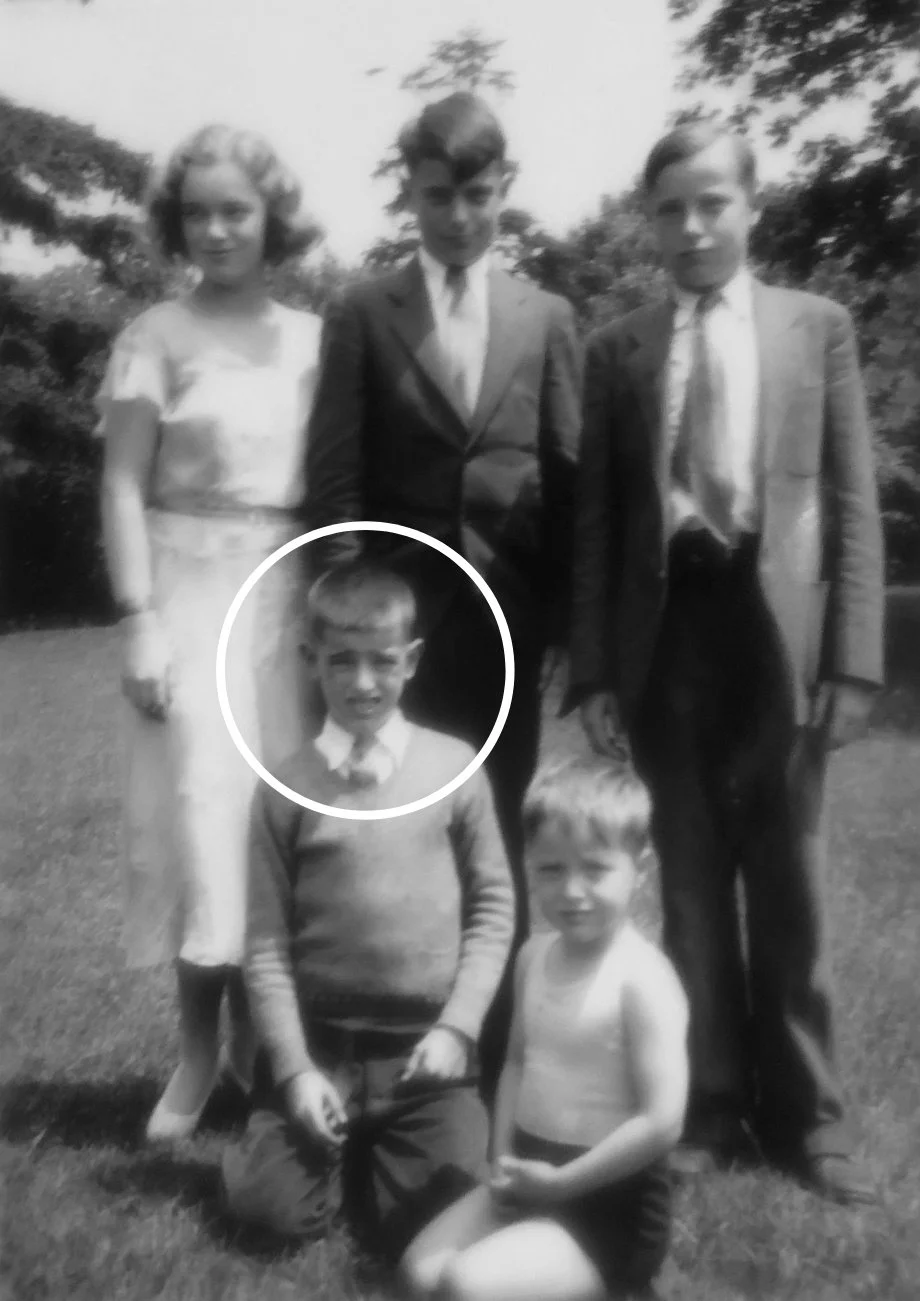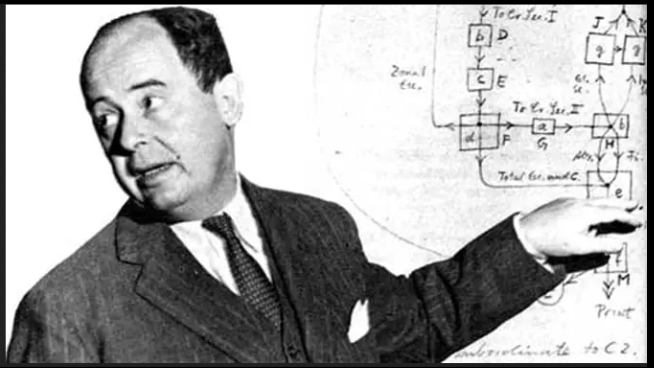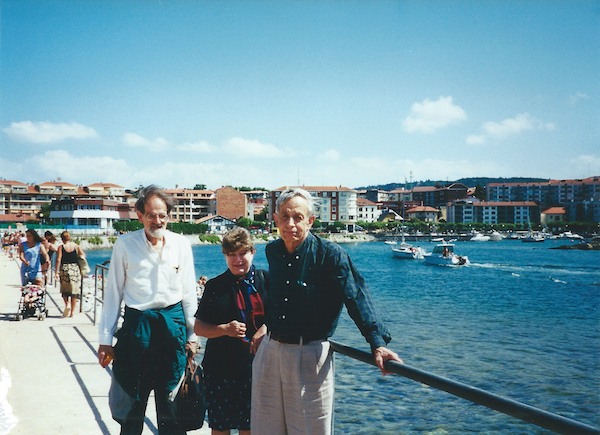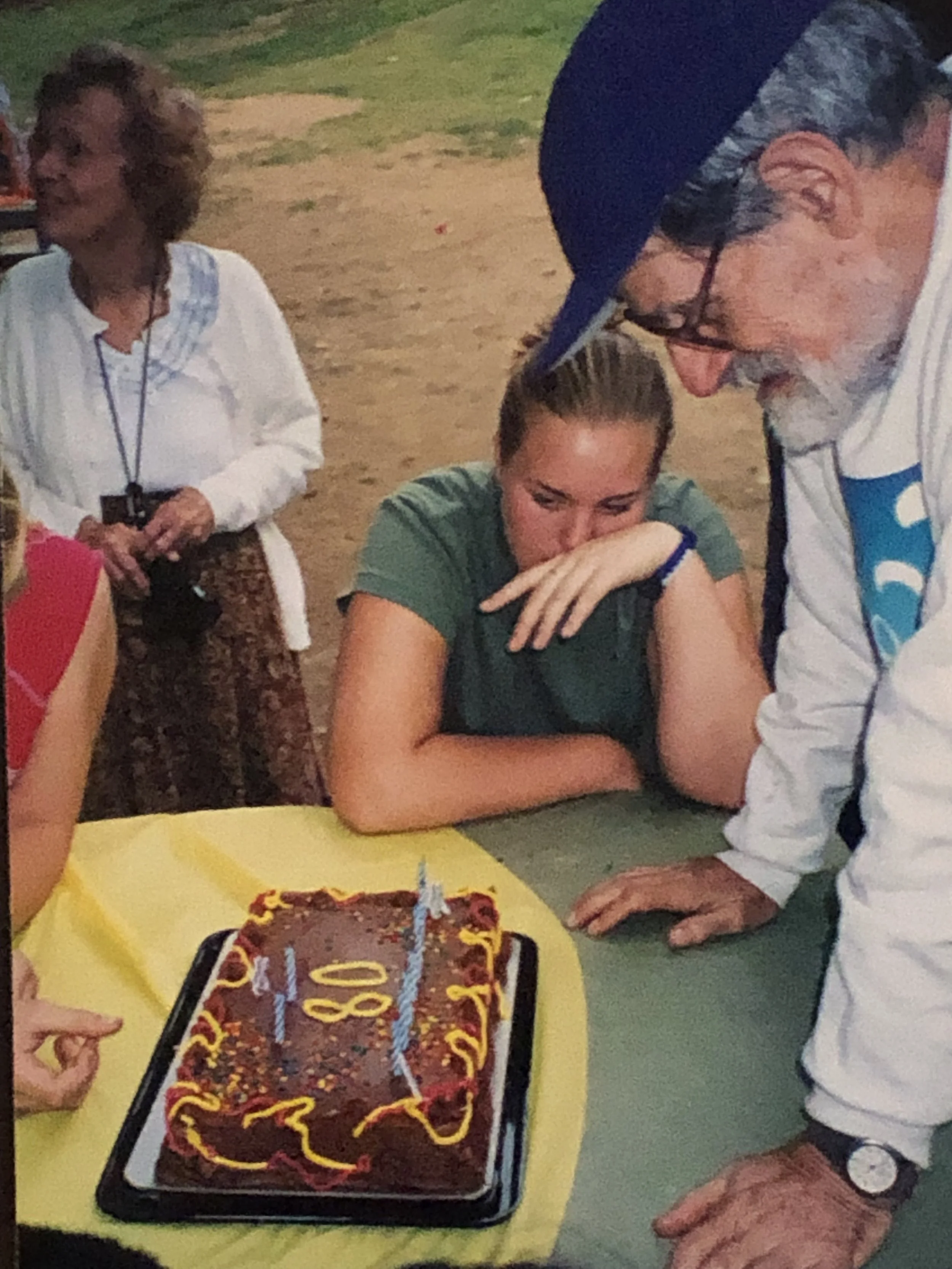STORIES
Do mathematicians only live in their heads and equations? The STORIES page shares anecdotes about Lloyd that family, colleagues and former students provided to show his human side. Besides Lloyd and his wife Marian, you'll find John von Neumann, Harlow Shapley, Martin Shubik and John F. Nash Jr.. Deborah Shapley and Lloyd's son Peter thank all who contributed, especially Pradeep Dubey and Xingwei Hu.
Hell’s Bells at age six
Lloyd is circled in this photo of the Shapley children by the Residence of the Director of Harvard College Observatory, Standing L to R: Mildred, Willis, Alan. Kneeling L to R: Lloyd, Carl. Shapley Collection.
Harlow and Martha Betz Shapley were great card players, Mildred writes. Once when the family could not agree which of them would sit out a 4-handed bridge game, Harlow settled it: “No bridge!”
“Zing, zing, zing, zing - he put down five cards face up on the table.” He said he didn’t know what this game was called. “I’m inventing it on the spot. Let’s call it Hells Bells.”
“OK, We have a seven, an eight, a king, a five and a deuce. Make a hundred out of it, using each card only once.”
They all competed as to who could produce the simplest solution fastest. Hells Bells became a regular pastime, she writes, because you don’t need a complete deck of cards! v
“We learned to do fast arithmetic under the pressure. As we became more proficient we introduced the inverse factorial and antilogarthims and…”
How to play Hell’s Bells and an early game recalled by Mildred.. Click for larger view.
“Alan, when he was ten, was once explaining this game to Professor Russell who was visiting us as he frequently did.….’And does little Lloyd play with you?’ Professor Russell wanted to know.
“‘Yes,’ and Russell was delighted with Alan’s reply, and often told about this apparent precocity. ‘Yes, sometimes he [Lloyd] does, and we let him use logarithms because he is only six.’” For more on their upbringing see Close-up: Life with the Director on this blog.
Von Neumann was happily scribbling
In his book “Von Neumann, Morgenstern, and the Creation of Game Theory,” Robert Leonard describes, how during a talk at the Rand Corporation, von Neumann was happily presenting his results.
“No! No! That can be done much more simply!” Lloyd interjected from the back of the room.
John von Neumann at the board. He could compute x when he was but six. Caption: Photo: Matematiksel.org
The room suddenly stood still and quiet; everyone could have heard a pin drop. “Come up, young man. Show me,” said von Neumann. So, Lloyd went up, took the chalk, and wrote down another derivation while von Neumann interrupted and said, “Not so fast, young man. I can’t follow.”
The young man’s solution was right. Johnny von Neumann after this meeting went over to John Williams and asked “Who is this boy?“ Williams replied he had hired young Lloyd Shapley after being told “he was a very promising young mathematician.” von Neumann asked: What has he been doing? Williams said:
“Oh well. Three or four research papers, each of which is the equivalent of a doctoral dissertation in mathematics.”
After this exchange, von Neumann invited Lloyd to come east to Princeton for a PhD.
This account is from Hans Speier who was in the room. This story is from Xingwei Hu, Lloyd’s former student at UCLA. See below Reminiscence by Xingwei Hu.
Shapley-Shubik value and the New Hampshire woods
Trees and overcast sky near Temple Mountain, Hillsborough County, N.H. Credit: Galant, June 2023.
“In formulating the Shapley value Lloyd wrote the axioms in part at Princeton and in part at his family’s summer home in Sharon New Hampshire. He had invited me to join them for Thanksgiving.” They drove from Princeton to the Observatory Residence at 60 Garden Street where “chocolate chip cookies and instructions had been left for us on the stairs.” The next day they drove north to Sharon.
“The time there was spent in individual work by all, with Lloyd concentrating on his value axioms.
“There was however a lengthy session on the porch overlooking the forest…with Harlow Shapley posing a simple problem to us. He observed that the trees were rocking to and fro violently and he conjectured that this motion was the cause of the heavy winds we were experiencing. Could we provide him with an experimental design to be able to prove or disprove this hypothesis?”
During that Thanksgiving with the Shapleys at Sharon, Shubik continues:
“It appeared to me that the Shapley value had an immediate application to voting in committee meetings and….where different individuals had a different number of votes.
“We wrote a small paper applying the Value to committee votes and much to our surprise the American Political Science Review accepted this paper from two unknown graduate students in a very few weeks.
“The value has gone on to be a seminal tool in many other uses.” From Martin Shubik “Lloyd Shapley In Memoriam, 2016” below. For more on the Shapley-Shubik Power Index see The Work page.
No marriage problem
Lloyd and Marian Shapley at wedding of Alan Shapley and Kay Mahoney, Boulder, Co. 1956. Harlow Shapley is at top right. Martha Shapley is at lower right. Lloyd and Marian married in 1955. Shapley Collection
From Deborah Shapley recalling visits to the Shapley’s rural place in Sharon, New Hampshire:
Once when I was quite young, I remember seeing my calm grandmother [Martha Shapley] surprised and excited. It was after Lloyd began working full-time at Rand and rarely came to Sharon.
“Lloyd telephoned!” she exclaimed.
“He told me he got a haircut!"
So? Lloyd made an expensive long-distance call to tell his mother he got a haircut?
With greater excitement, she added: ‘Then he said he got married!” I recall everybody being happy about it.
Lloyd Shapley and Marian Ludolph worked at Rand. She was a secretary and then a computer programmer. They wanted to get married. So, according to their son Peter, at lunchtime on August 19, 1955, they walked from the RAND office across Main Street to the LA County courthouse, got wed, and returned to the office.
Marian later got an MA and PhD from UCLA in linguistics, specializing in discourse analysis. They were married until her death in 1997.
The law of mazes
The Shapleys’ 100 acres of woodland and brooks in Sharon, New Hampshire, had once been a farm. It had views of Temple Mountain in one direction and of Mount Monadnock in the other. Lloyd, Willis, Alan and Harlow cut trails through the woods. They built things; the old barn was the toolshed. They planted a double ring of pine trees.
Lloyd designed a maze for one of the open spaces. It would violate the law of mazes, he told us. In a normal two-dimensional maze you can always get out by sticking to the wall on one side and keep going. Lloyd’s maze would violate that law by having a third dimension: an overpass.
Left: “Lloyd’s maze” is newly planted in 1955. The overpass is clearly seen. Right: Harlow standing on the overpass after the bushes have grown a bit. Shapley-Matthews Collection
Mildred Shapley Matthews writes: “Lloyd designed and constructed a maze using 600 baby spruce and junipers, mostly hauled up from the banks of the brook. At one point there was an over- and under-pass to the delight of small fry and the risk of adults.
“For the old hands who had learned the solution, the game was to see how fast you could run through the maze with its 13 dead ends.”
Some trees in the maze died. So “there would be an annual summer job of replacing the dead ones, so that people couldn’t cheat by going through unintended open spaces.” More on Sharon at Close-up: Life with the Director.
Help to stressed colleagues
Lloyd had a complicated relationship with the brilliant, troubled John F. Nash, Jr. They were roommates (along with Martin Shubik) when they were PhD students at Princeton. Nash was also at Rand briefly when Lloyd was there. Sylvia Nasar’s best-selling book on Nash A Beautiful Mind describes how Nash’s mental problems caused him to leave research. Nasar writes that later, Lloyd nominated Nash for the prestigious von Neumann Theory Prize “to do something for Nash.” Nash received the prize in 1978. “He was an immense genius,” Lloyd told Nazar. “He was obnoxious…What redeemed him was a keen, beautiful logical mind.” Thus Lloyd gave Nasar the title for her book.
See also Lloyd Shapley - Nobelist on this blog.
Lloyd Shapley, Alicia Lardé and John F. Nash, Jr. in Bilbao, Spain, for the First World Congress of the Game Theory Society, July, 2000. Photo: Shapley Collection
Xingwei Hu shares this story of Lloyd helping a mentally stressed colleague:
“Before I entered UCLA in 1996, there was a mentally stressed graduate student in the math department called Johann. He had previously worked with two other faculty members but failed to make any progress. So, likely, no other professors would supervise Johann on his dissertation. But Lloyd was an exception. Also, Johann lost any financial support from the department since he had been there for over six years. He had tried teaching classes in community colleges, such as Pasadena City College, but all resulted in dismissal because of his mental problem. When Lloyd knew this, he offered Johann $1,500 monthly from his personal savings until his graduation in 2004.”
From Xingwei Hu The Master of Games: Lloyd Shapley.pdf
Lloyd’s mysterious desk drawer
Professor Lloyd S. Shapley in his office in the math department, UCLA, late 1990s. Photo: Xingwei Hu
“At that time, economics graduate students and professors knew Lloyd’s famous drawer: each manuscript from the drawer was worth a good publication. All of Lloyd's doctoral students were so lucky because we built our dissertations upon the foundations he laid many years ago. …. Later, I found that some results in [my] derivations were already stated, without proof, in his informal publications in the 1960s.
“Later publications by other authors may be just special cases of Lloyd’s general results, that did not appear in academic journals. He left many ideas and manuscripts unpublished; others were overly delayed. Also, some of his original ideas and solution concepts were not written out in any manuscripts. They could be in letters, emails, or oral communications …. I hope these unpublished manuscripts and solutions will come out soon to benefit the academic world.” Xingwei Hu received his doctorate at UCLA in 2000 guided by Lloyd Shapley. See Xingwei Hu: The Master of Games: Lloyd Shapley.pdf
Solve this if you want your cake
Caption: Left to Right Mildred Shapley Matthews, Raissa Marchetti-Kozlov and Lloyd in familiar attire. Raisa is Chip Shapley’s step-daughter; her mother is Chip’s wife Roseanna. Credit: Shapley Collection
For birthdays in the Shapley family, the candles were arranged as a mathematical puzzle. Presented with his own birthday cake, Lloyd had to solve the puzzle correctly before he was allowed to blow them out! Here the solution will be 80 - he knows that! But how to get 80 from this arrangement of 10 candles?
_ X _ X _ _ _ _
X X X X X X X X
Solution: In binary the above represents 01010000 which is 80 in base 2. “In computer stuff - trivial,” notes Peter Shapley, who provided the snapshot and the puzzle. He says his brother Chip objected that this puzzle was too easy. The puzzle was solved quickly and the cake was enjoyed.
If you have stories to share about Lloyd Shapley, please write us at Contact.





